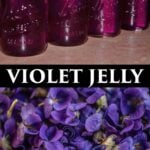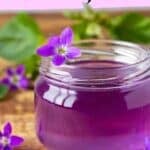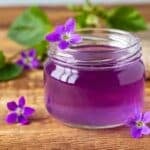Violet Jelly Recipe – Traditional and Less Sugar Options
This post may contain affiliate links. Read my full disclosure here.
Violet blooms are not only a beautiful sign of spring, they’re also edible. Making wild violet jelly is a simple and rewarding way to preserve a bit of spring’s charm in a jar. The jelly ranges in color from soft lavender to brilliant pink, depending on the pH and violet variety.
During the Victorian era, violets symbolized modesty, innocence, and true love. Some folklore claims that carrying violets can protect against evil and grant wishes if the flowers are picked with dew still clinging to them at dawn. No luck on proving those claims so far, but the jelly is tasty.
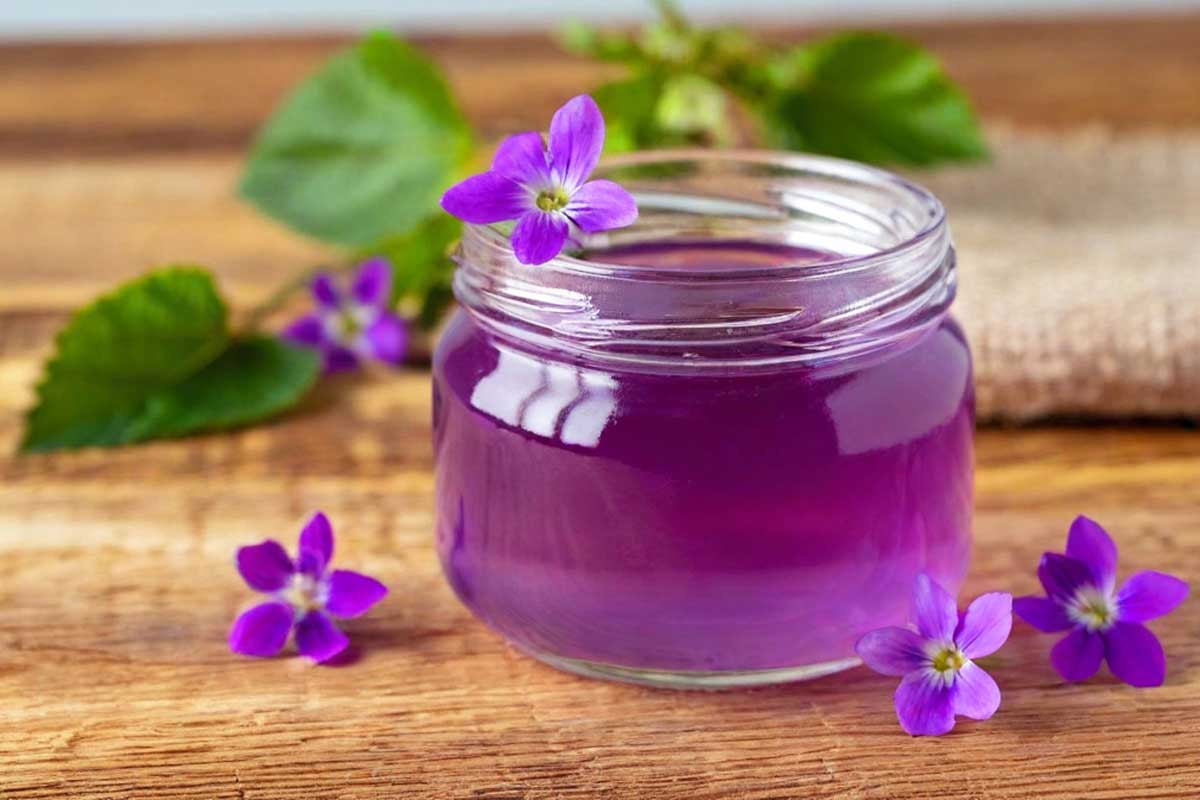
We’ll walk you through two ways to make violet jelly: one using traditional full-sugar pectin and a low- or no-sugar option. Both methods start with making violet tea—essential for getting that gorgeous color and delicate floral flavor. The recipes are safe for water bath canning, or you can store your jelly jars in the refrigerator.
Table of contents
Foraging and Preparing Wild Violets for Jelly
Safe edible violets:
- Common Blue Violet (Viola sororia)
- Viola sororia f. rubra (pink form of Common Blue Violet)
- Sweet Violet (Viola odorata)
- Marsh Blue Violet (Viola cucullata)
- Wood Violet (Viola papilionacea)
These species are found across North America and Europe, and their flowers (and young leaves) are safe for eating. Look for heart-shaped leaves and five-petaled flowers (purple, blue, or white).
Avoid African violets (Saintpaulia spp.), which are not true violets! These are houseplants and NOT edible.
Harvesting Tips
- Pick in clean, pesticide-free areas.
- Collect about 2–3 cups of fresh violet flowers, loosely packed.
- Flowers should smell lightly sweet or grassy (never bitter or chemical-like).
- Choose fully opened, fresh blossoms.
- Rinse gently to remove any insects or debris.
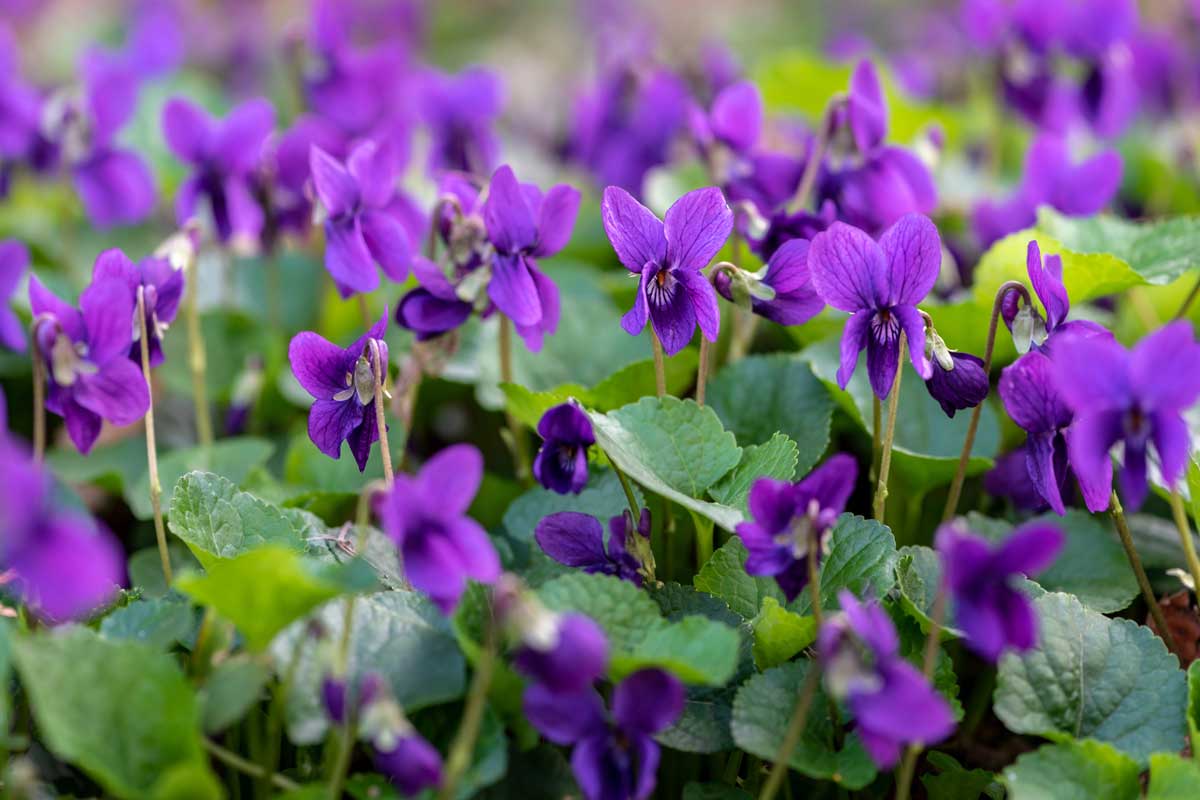
Step 1: Make Violet Tea
Violet tea is the beautiful, color-changing base for your jelly. Use glass or ceramic to steep the petals—metal can affect the color. You can freeze violet tea until you’re ready to make jelly. If you like, you can also include some dried lavender for stronger floral notes.
Ingredients:
Would you like to save this?
- 2- 3 cups of violet petals (fresh, loosely packed)
- 2 1/2 cups boiling water
Instructions:
- Pour the 2 1/2 cups of boiling water over the flowers in a glass jar or bowl.
- Cover and steep for several hours (or overnight).
- Strain through a fine mesh sieve or cheesecloth. Compost the petals.
- At this stage, the tea may be blue-green or murky gray—don’t worry! It will turn pink or purple with lemon juice.
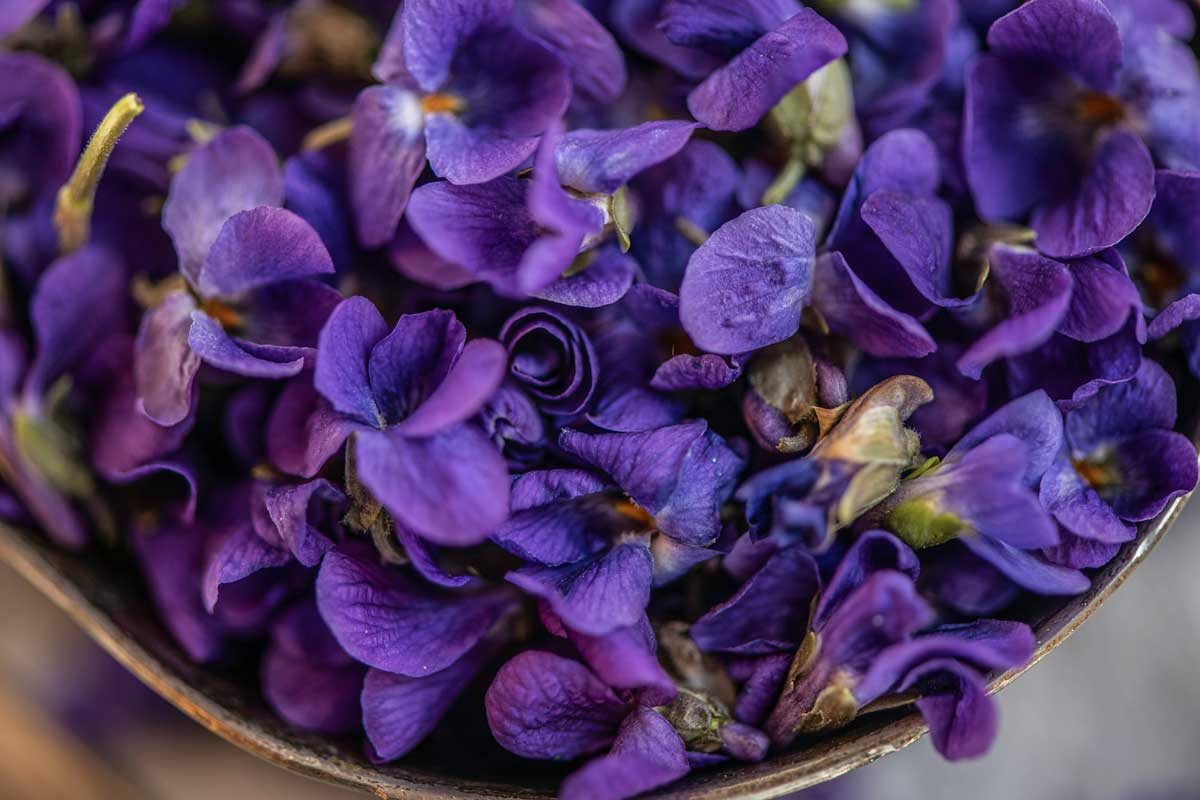
Violet Jelly with Full Sugar Pectin
This old fashioned jelly
- Prep Time: 10 minutes
- Cook Time: 10 minutes
- Total Time: 20 minutes
- Yield: 4 cups 1x
- Category: jelly
Ingredients
- 2 1/2 cups violet tea
- 1/4 cup lemon juice (fresh or bottled)
- 1 box (1.75 oz) regular powdered pectin (e.g., Sure-Jell)
- 3 1/2 cups granulated sugar
Instructions
- Pour violet tea into a saucepan and add lemon juice. Watch it change color!
- Stir in the powdered pectin and bring to a rolling boil.
- Add sugar all at once and stir constantly.
- Return to a full rolling boil on high heat. Boil hard for 1–2 minutes.
- Remove from heat and skim foam if needed.
- Ladle into sterilized canning jars, leaving ¼” headspace.
- Process in a boiling water bath for 10 minutes (adjust for altitude).
- Remove mason jars from canner and allow to cool to room temperature.
- Remove rings and check seals. Label your jars with the date and recipe used.
- Use within a year for best quality, refrigerate after opening.
Notes
Violet Tea
Ingredients:
- 2 – 3 cups fresh violet petals (loosely packed)
- 2 1/2 cups boiling water
Instructions:
- Pour the 2 1/2 cups of boiling water over the flowers in a glass jar or bowl.
- Cover and steep for several hours (or overnight).
- Strain through a fine mesh sieve or cheesecloth. Compost the petals.
- At this stage, the tea may be blue-green or murky gray—don’t worry! It will turn pink or purple with lemon juice.
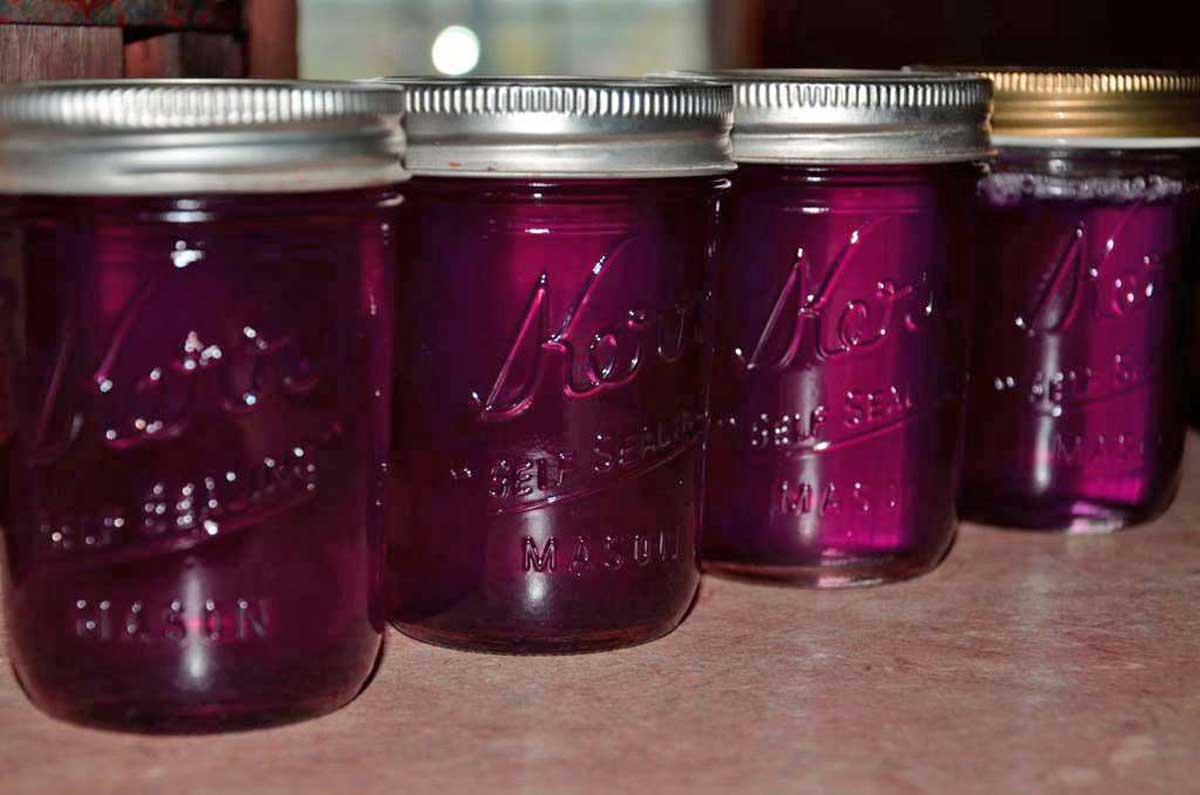
Low-Sugar Violet Jelly Using Pomona’s Universal Pectin
Pomona’s pectin uses calcium to gel, allowing flexibility in sweeteners. Learn more about Pomona’s Universal Pectin.
- Prep Time: 10 minutes
- Cook Time: 10 minutes
- Total Time: 20 minutes
- Yield: 3 cups 1x
- Category: Jelly
Ingredients
- 2 cups violet tea
- 1/4 cup lemon juice
- 1 1/2 tsp Pomona’s pectin powder
- 2 tsp calcium water (comes with Pomona’s pectin)
- 1/2 – 1 cup sugar or 1/2 cup honey (or to taste)
Instructions
- Prepare calcium water according to Pomona’s instructions.
- Combine violet tea, lemon juice, and calcium water in a pot.
- In a separate bowl, mix sugar or honey with pectin powder.
- Bring tea mixture to a boil.
- Add the sugar-pectin mix and stir well for 1–2 minutes until dissolved.
- Return to boil, then remove from heat.
- Ladle into sterilized jars, leaving ¼” headspace.
- Process in a boiling water bath for 10 minutes (adjust for altitude).
- Remove jars from canner and allow to cool completely on the counter.
- Check seals, date, and label. Store in a cool, dark location. Use within a year for best quality. Refrigerate after opening.
Notes
Violet Tea
Ingredients:
- 2 – 3 cups fresh violet petals (loosely packed)
- 2 1/2 cups boiling water
Instructions:
- Pour the 2 1/2 cups of boiling water over the flowers in a glass jar or bowl.
- Cover and steep for several hours (or overnight).
- Strain through a fine mesh sieve or cheesecloth. Compost the petals.
- At this stage, the tea may be blue-green or murky gray—don’t worry! It will turn pink or purple with lemon juice.
If you like, you can make a half batch or double batch of the low sugar violet jelly recipe, since one packet of Pomona’s makes multiple batches of jelly. I like to make mini jars and share them with friends who aren’t big jelly eaters, but like to sample different things.
Violet Jelly FAQ
Violet jelly has a delicate, lightly floral flavor with soft notes of grape. It’s not overwhelming floral.
Violet tea reacts to pH. Add enough lemon juice and it will shift to a pink or purple hue.
For best results, make full sugar jelly in small batches. Doubling can affect the jelly’s ability to set. It’s okay to make a double batch with Pomona’s Pectin (which is another reason that I like it!)
Wait 24–48 hours. If it still doesn’t set, reheat with additional pectin or use as a syrup for pancakes and drinks.
Yes! You can use honey, maple syrup, stevia, or even make a no-sweetener version.
Yes. Lemon juice is essential for both safety (acidifying the jelly) and for the beautiful color transformation.
Fresh violets yield the best flavor and color, but you can try using 1 cup of dried petals. The jelly may be less vibrant.
More Flower Jellies
It’s fun to experiment with edible flowers to make different jellies, and to use them to brighten any dish. (Make sure check out our list of over 50 edible flowers, with tips for use.)
Some of the flower jellies we’ve enjoyed include:

This article is written by Laurie Neverman. Laurie was raised on a small dairy farm in northwest Wisconsin, where she gathered wildflowers from the woods and pastures. She and her family now live in northeast Wisconsin, where they combine intentional plantings and semi-wild areas. Every season is a new opportunity to learn more about working with wild plants.

